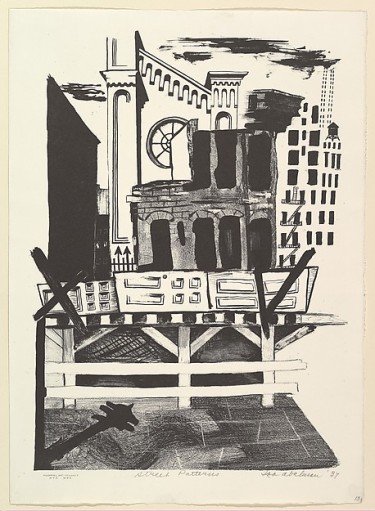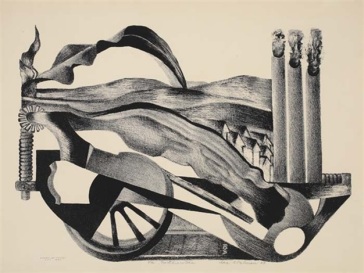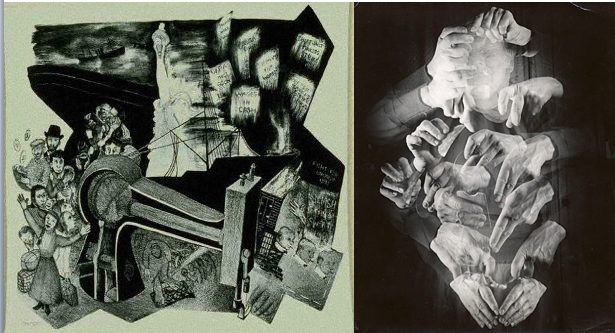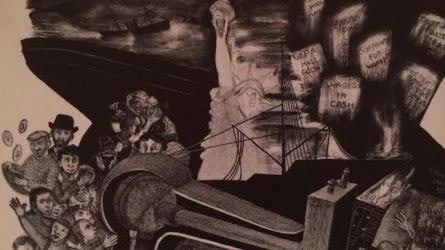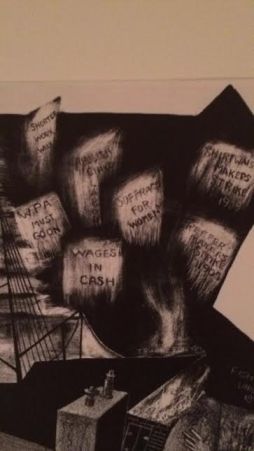Ida Abelman is well known for her combination of different styles of art, including surrealism, constructivism, and social realism. It is important to define the themes in her artwork because only then can it be framed in the context of social commentary appropriate for the time period. Art themes that convey important social, economic, and political messages of the time transform the function of works from “for viewing purposes” to “for learning purposes”
- Surrealism: the goal of surrealism was to release the creative unconscious through the juxtaposition of irrational images.
- Constructivism: Constructivism is a form of art that supports the use of architecture, graphic design, illustration, theater, film, dance, music, and other forms of art as a practice having social impact, that is, created with a message.
- Social realism: Social realism describes the work of artists that draw attention to the struggles and realistic conditions of the poor and working class. These paintings, photographs, and/or films criticize the social structure that cause or maintain these conditions.
Man and Machine
This painting most obviously demonstrates social realism by illustrating how machines encompassed men at the time. The Great Depression was characterized by a heavy emphasis in the machine industry. The Industrial Revolution, the transition to new manufacturing processes, had occurred almost 100 years ago. The most accessible job market was that of manufacturing. In this way the painting shows the struggles of the working class to find positions that paid enough to uphold themselves or their families and not physically injure themselves in the process.
Street Patterns
“Street Patterns” was painted by Ida Abelman in 1937, and represents an abstract depiction of the New York City Skyline from a rooftop. There is integration of skyscrapers, and the shadow made from the viewpoint seems to resemble a guitar neck. The usage of dark shades of grey, black, and white are consistent with her depressive themes. Indeed, the city seems still, which reflects the aura of the Great Depression.
Wonders of Our Time
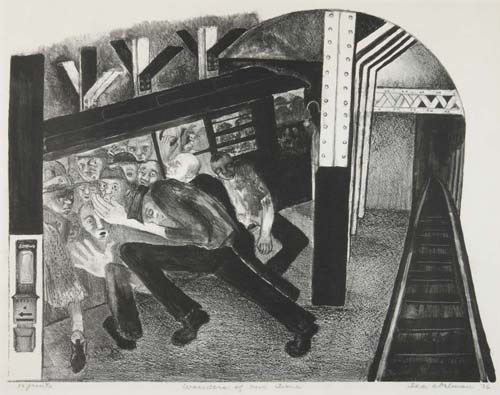
“Wonders of Our Time” was painted by Ida Abelman in 1937 and can be found in the Whitney Museum of Art. It is consistent with the social changes of New York City at the time, as the city had begun construction on the subway system only 30 years prior, and it was rapidly spreading. It varies in its black, white, and grey shades to create a somber mood regarding the city. This can be connected to using the subway as a work commute, path to interviews, or other events that are associated with the Great Depression. The odd angles of the train and exaggerated facial expressions uphold Abelman’s constant themes of Surrealism. “Some of the figures look back at the viewer as if, in an act of desperation, to ask for help. The scene reveals an unnerving parallel between competition for seats among subway riders and Dawin’s theory of natural selection. As Abelman’s passengers squeeze their way into the war, the fittest, or the most aggressive, get seats while the weakest are left behind. Crowding was always a problem in the subway, but after World War I it became unbearable.”
“Many of Abelman s contemporaries, including Louis Lozowick, believed the machine was a powerful positive force, and that artists should express the machine’s potential for facilitating democratic progress. In contrast, Wonders of Our Time communicates an uneasiness about the impact of machines on society. Human reaction to the mechanical marvels that were beginning to organize urban life includes frustration, and dismay as people crowd onto a subway train. There is a satirical edge to Ableman’s view of humanity in awe of mechanical and technical progress, yet at the same time fearful of the potentially negative effect of the machine on the quality of human life” (Francey).
Other works:
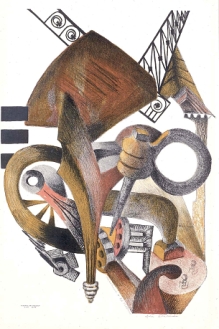 Machine + “El” Patterns, 1935-1943
Machine + “El” Patterns, 1935-1943
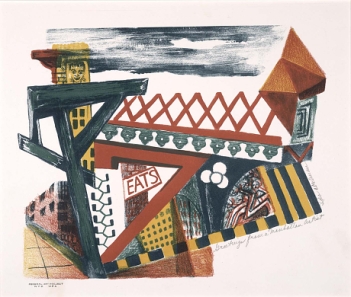 Greetings From a Manhattan Artist, 1935–43
Greetings From a Manhattan Artist, 1935–43
Art Front:
My Father Reminisces vs. Art Front Painting
My Father Reminisces
1935
Allocated by the government, commissioned through the New Deal art projects
37 cm x 46.9 cm (14 9/16 in. x 18 7/16 in.)
print, offset lithograph
Ida Abelman’s artwork was featured in several galleries as part of the “Federal Arts Project” movement of Great Depression and Post World War II America. Her pieces, like many others from these projects, made social commentary on the political and economic events of the era. My Father Reminisces combines these modernist styles in an abstracted representation of a persuasive message of the tragedies that faced the working class during the depression and World War II. In this manner, it “resolved the contradictory conditions of dream and reality”, and illustrated surrealism. It gave the unconscious a voice by painting abstract and illogical figures based on real political, social, and economic problems. This piece is an an abstract representation of a persuasive message of the tragedies that faced the working class during the depression representing Ida Abelman’s world during this time period. This large lithograph was seen in Art Front (May 1937), where Abelman’s artwork was viewed as one that “took all the themes that had been suggested to the Committee by the ILGWU and compressed them within one image. An extraordinary composite of immigrant life and labour struggles, it uses collage devices to describe a complex historical narrative stretching from left to right through the massage and arrival of immigrants, the exploration of the sweatshops, the formation of the ILGWU, the Triangle Shirtwaist Fire and successful strike activity” (Hemingway). Nowadays, although this piece receives much appraisal it is still unknown how successful it was towards Abelman’s intended viewers (union audiences). “But in late 1938 the United American Printmakers within the recently renamed United American Artist launched a campaign to distribute such mass-produced prints through the union movement” (Hemingway), where it is assumed appraisal was gained.
Art Front piece– Marguerite Wildenhain showing the motion of hands making a pot, ca. 1945
 Physical Details: Photographic print : 1 item : b&w ; 34 x 27 cm.
Physical Details: Photographic print : 1 item : b&w ; 34 x 27 cm.
Creator: Otto Hagel, photographer
Description: Time lapse photography showing Wildenhain’s hands in the motions of making a pot.
Forms part of: Marguerite Wildenhain papers, 1930-1982
Citation: Marguerite Wildenhain showing the motion of hands making a pot, ca. 1945 / Otto Hagel, photographer. Marguerite Wildenhain papers, Archives of American Art, Smithsonian Institution.
This painting is similar to Abelman’s because it fixates on the importance of manual work. However, it is different because it does not exhibit social realism. Rather than send a message of the struggles and importance of manual labor, it exhibits the art of pot-making as nothing more than an art. Indeed, the process is meant to be admired for it’s beauty, but a social message is not intended for the viewer. In contrast, “My Father Reminisces” includes the bodies of human workers juxtaposed with symbols of American freedom and industrial machines to send a message of the difficulty of becoming employed during the great depression.

